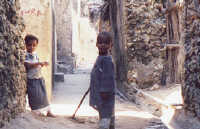At Home in Lamu
Lamu, Kenya
|
![]()
Lamu is about 95% Muslim, and five times a day the mournful singing from the mosques calls the faithful to drop what they’re doing and reassert their faith. You always know what time it is when you see the slippers in a messy heap on the mosque steps, and you can have a brief glimpse inside of the kofia– and kanzu-clad men praying and kneeling. The women float gracefully in their buibuis, traditional black robes that cover them from head to toe, sometimes even their faces, depending on their mood. At first I thought that a pair of eyes peering out of all that black cloth represented a more conservative girl, or one with a stricter husband, but everyone assured me it was purely their own decision. I soon realized that most of the women who covered their faces were the younger ones, often using special buibuis with lace and glittery beads. In a society where no skin is allowed, girls invent ways to flirt by surrounding their eyes in tantalizing shimmery cloth.
From the rooftop of Kilimanjaro Lodge, I would watch the little boys dressed in white on their way to school, teenage girls gossiping, and women hanging clothes to dry on the neighboring roofs. The rest of Lamu is Christian, mostly Kenyans from up-country. From time to time the sleepy square fills with the singing and dancing of a Christian revival, giving the place the feel of an outdoor Broadway musical, with coconut sellers and barefoot kids part of the scenery.
|
![]()
Lamu’s most endearing characteristic might be its lack of cars; its streets are much too narrow and winding to accommodate for anything but donkeys and people. The one car on the island belongs to the District Commissioner and is only used for unnecessarily driving up and down the waterfront. Donkeys and dhows remain the preferred mode of transport. Children play on the streets with their medieval toys, rolling metal rings with wires among the human traffic. The lack of cars gives Lamu its time-warp atmosphere; there are no paved roads, no traffic lights. It is a town built on top of sand and dirt.
Sometimes when I had to rush to the polytechnic school where I had started teaching, the men resting in the shade of doorways and trees would call out to me: “Pole pole! Lamu hakuna haraka!” – “Slow down! There’s no hurry in Lamu!” And for them there never was any hurry: women would stand in the market all day waiting to sell their fruits and vegetables, while their dirt-smudged children would climb over and under the tables; the old men in the plaza would chat under the trees until it was time to pray again; the beach boys would idly smoke their singly-bought cigarettes, moving only when the sight of mzungu skin woke them from their trance; and the waiters at New Star would take your order and then disappear into the kitchen for several hours.
This laid-back attitude caused me many frustrations and it pervaded every aspect of life. But gradually I fell into the rhythm and accepted it, the way I accepted the occasional electricity failures, the water shortages, and the violent downpours during rainy season. After a while I realized I had stopped counting time in hours and minutes, but by the sun and moon and when mango season would start again.

